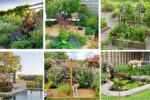Water features bring serenity and movement to garden spaces but it’s the right plants that truly make them come alive. Cascading water plants add grace and texture, softening edges, spilling over rocks, or trailing into shimmering ponds. They can cool the water, provide shelter for wildlife, and enhance the naturalistic beauty of fountains, waterfalls, and stream beds. Whether you want lush greenery or vibrant color, these 10 cascading water plants will elevate your aquatic garden with charm, motion, and elegance.
1. Water Mint (Mentha aquatica)

Water mint is a highly aromatic plant with lush green to purple-tinged foliage and charming lavender flower clusters that attract bees and butterflies. Native to Europe and Asia, it thrives along pond edges or in shallow water. It naturally spills over rocks and edges, forming dense mats that beautifully soften hard lines. Water mint prefers full sun to partial shade and grows best in moist or boggy soil. Its fresh, minty scent adds sensory appeal, and it’s ideal for naturalizing stream banks.
2. Creeping Jenny (Lysimachia nummularia ‘Aurea’)

Known for its golden yellow leaves and trailing habit, Creeping Jenny brightens the margins of ponds and waterfalls with a pop of vibrant color. It cascades beautifully over rocks, retaining walls, or container edges and is perfect for softening the structure of a water feature. Hardy in zones 3–9, it prefers moist soil and partial shade but can adapt to sunnier spots near water. Its cheerful appearance and low-growing spread make it a top choice for adding texture and contrast.
3. Parrot’s Feather (Myriophyllum aquaticum)

Parrot’s Feather lives up to its name with finely feathered, vivid green to blue-green foliage that looks like it belongs in a tropical jungle. Ideal for streams, pond edges, and small waterfalls, it sends its lacy leaves trailing beautifully across the surface of the water and down banks. Hardy in zones 6–10, it requires full to partial sun and thrives in shallow, still water. It also provides excellent shelter for fish and insects. Use with care it can spread aggressively in warm climates.
4. Trailing Lobelia (Lobelia erinus)

With its delicate cascading stems and masses of brilliant blue, purple, or white flowers, trailing lobelia adds a splash of vibrant color to any pondside or water container. It’s often grown as an annual in most climates but performs as a perennial in zones 10–11. Ideal for planting in pockets of moist soil along pond edges or in containers on waterfall ledges, it prefers part shade and rich, damp soil. Its trailing growth habit softens rock work and attracts hummingbirds and bees.
5. Watercress (Nasturtium officinale)

Watercress is more than just a tasty salad green it’s also a beautiful, cascading aquatic plant perfect for moving water. Thriving in clean, shallow streams and pond overflows, watercress spills attractively over rocks and ledges. It prefers partial sun and cool, oxygen-rich water. As it trails, it creates shelter for small aquatic creatures and adds a lush, edible element to your pondscape. Regular harvesting keeps it tidy and productive. It’s especially useful in natural ponds and eco-conscious water gardens.
6. Sweet Flag (Acorus gramineus ‘Ogon’)

Sweet flag is a grass-like, moisture-loving plant with striking yellow and green variegated foliage that gently cascades over pond edges. The ‘Ogon’ variety, in particular, adds brightness and movement with its fine-textured blades. Hardy in zones 5–9, it prefers part shade and consistently wet soil, making it ideal for the margins of ponds or slow-moving streams. Though not a true aquatic plant, it performs beautifully in shallow water settings and adds an elegant, grassy element that sways with the breeze.
7. Bacopa (Bacopa monnieri or Bacopa caroliniana)

Bacopa is a low-growing, spreading plant known for its small, succulent-like leaves and delicate white, blue, or lavender flowers. It thrives in shallow water or along the edges of ponds and containers, cascading gently over the sides. Bacopa monnieri, also called water hyssop, is often used in herbal medicine and grows well in warm, humid conditions. It’s a great choice for softening hardscape features like stone or ceramic water bowls. In zones 8–11, it acts as a perennial, while cooler climates can enjoy it as an annual.
8. Golden Club (Orontium aquaticum)

Golden Club is an elegant native aquatic plant with long, arching leaves and unique yellow flower spikes that resemble golden matchsticks. Its foliage flows gracefully over pond margins and into shallow water, creating a soft, natural look. Hardy in zones 5–9, it prefers full sun to part shade and can tolerate varying water depths. Its roots anchor in the substrate while leaves and blooms drift across the surface or cascade down slopes. Golden Club provides visual interest while blending seamlessly into naturalistic pond settings.
9. Bluebell Creeper (Billardiera heterophylla)

Though not traditionally aquatic, Bluebell Creeper is a gorgeous trailing plant that can thrive in wet soil and cascades beautifully over pond edges and containers. Native to Australia, this twining plant produces bell-shaped blue to violet flowers throughout summer. It’s best used in raised pond containers or nearby planters where its stems can drape into water or over rocks. Hardy in zones 9–11, it loves bright light and moist soil. The whimsical blooms attract pollinators and add romantic charm to water features.
10. Pennywort (Hydrocotyle spp.)

Pennywort is a charming aquatic creeper with small, round, lily-pad-like leaves that trail over rocks, pond edges, and wet soil. It’s ideal for softening the outlines of fountains, cascades, and stream edges. Several species, like Hydrocotyle verticillata and Hydrocotyle umbellata, thrive in warm, shallow water and form dense mats that reduce algae by shading the water surface. Its lush green growth adds natural, low-lying interest and provides shelter for amphibians and aquatic insects. Pennywort is easy to grow and propagate, making it a great low-maintenance option.



